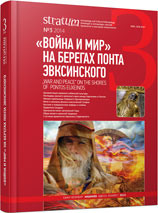Образ вепря в иранской традиции — нарратив и визуализация
The Image of Boar in the Iranian Tradition — Narrative and Visuality
Author(s): Hanna V. VertiienkoSubject(s): History, Archaeology, Fine Arts / Performing Arts, Cultural history, Visual Arts, History of ideas, Ancient World
Published by: Издательский дом Stratum, Университет «Высшая антропологическая школа»
Keywords: Sassanian Iran; Scythia; boar; Avesta; Verethragna; art; kingship; hvarn
Summary/Abstract: The image of a wild boar is a widespread motive in written and pictorial tradition of the Iranian people of Antiquity. In the Young Avestan texts the boar is the steady embodiment of Verethragna (Yasht 14, 15 (2—8). The same refrain repeats in Yasht 10, 70 (3—9) and 127 (2—8). In Yasht 10, 70 parts of the animal's body correspond to metal, which can be the image of the blade weapon (dagger/karəta-). Connection of a boar with the military sphere is traced during the Sassanian period in the “Memorials of Zarer’s son” (45). In the Iranian art of that period, the royal boar hunting motive gets a special spreading, that points to communication of this animal with all-Iranian royal representation of hvarn (xvarənah-). In the art of the Iranophone nomads, the motive of a boar gained diffusion on a weapon decor (a sheath of short swords and gorytos), bowls, and also on the topic scenes of hunting and fight. Images of boar on such objects were a marker of the highest social status of their owners in military hierarchy of the nomadic aristocracy.
Journal: Stratum plus. Археология и культурная антропология
- Issue Year: 2014
- Issue No: 3
- Page Range: 271-280
- Page Count: 10
- Language: Russian

